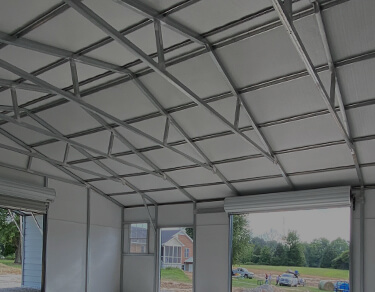
Metal Building Insulation: Benefits, Types, Cost, & Tips

Say goodbye to sweltering summers and freezing winters with metal roof and wall panel insulation in your metal building! This game-changing upgrade boosts comfort and enhances productivity in commercial garages and workshops. Keep your metal structure strong and energy-efficient with thermal custom metal building insulation. With many options available, finding the perfect fit for your building can be overwhelming. But don’t worry—there’s much to discover about metal building insulation’s types, uses, and benefits!”
Types of Metal Building Insulation
While looking for the ideal option for insulating your metal building, selecting the most appropriate insulation is essential to ensure energy efficiency, comfort, and longevity. Here are some of the most suitable insulation types for metal buildings:
-
Spray Foam Insulation
A fluid insulation material consisting of two parts, spray foam, insulates the area where it is applied. It is a type of insulation that never sags or loses shape over time and is available in both open-cell and closed-cell varieties. The insulation seals off large open spaces like attics and pole barns from the outside air. This kind of insulation is generally more expensive than other insulation options.
-
Fiberglass Batt Insulation
Fiberglass insulation is not only one of the most affordable options, but it’s also easy to install. DIYers can handle the installation with essential tools and safety equipment. This type of insulation offers a good R-value and decent thermal insulation, making it a cost-effective choice for many. It lets you invest smartly in your building’s comfort and energy efficiency, making you feel financially savvy.
The conventional insulation method, which is cut and rolled up, is called batt or blanket insulation. These woven fiberglass sheets, which resemble wool, fit easily between framing because they are roughly three inches thick.
Blanket insulation is typically inexpensive, non-flammable, and easily accessible at home improvement stores for installers and contractors. However, batt is renowned for its acoustic properties and ability to regulate climate. If your production facility is noisy and you live near a residential area, batt is an excellent option because the tiny shards absorb sounds from both directions.
-
Rigid Board Insulation
Rigid board insulation is a common substitute for spray foam systems and conventional fiberglass blankets. Made of polystyrene, polyurethane, or polyisocyanurate plastics, rigid foam boards are thin and stiff, ranging from 0.5 to 2 inches thick. When cut accurately, they are easily secured between steel framing components.
Rigid foam boards are also classified as ‘continuous insulation systems.’ When properly installed, they create a continuous, gapless barrier across all structural parts, preventing thermal bridging and heat loss or gain through the building’s structure.
In short, the insulation creates a seal around the interior of the building, preventing heat from escaping or entering through other structural elements like conductive steel purlins. Higher numbers indicate better insulation. The “R-value” gauges the insulation’s thermal resistance. The rigid board insulation’s airtight seal and firmness make it perfect for flat rooftops.
Benefits of Metal Building Insulation
-
Regulate Temperature
Steel building insulation eliminates the demand for excessive heating or cooling by assisting in regulating interior temperature.
-
Heat Transfer
Heat transmission can be especially problematic in metal buildings. Insulation reduces heat transfer by acting as a barrier, so your HVAC system will need less energy to maintain a pleasant interior temperature.
-
Cozy Space
Insulated metal panels maintain a constant interior temperature so that you can enjoy a cozy and inviting space no matter the weather.
-
Reduced Noise
Steel building insulation reduces noise from the building. This feature is beneficial in residential settings where silence is crucial or commercial settings where noise might interfere with work.
-
Balanced Condensation
Metal insulation in buildings aids in regulating moisture and condensation, avoiding wetness and mold growth. A dry interior is necessary for comfort and health reasons, and insulation is critical in making this happen.
Material and Final Costs of Metal Building Insulation
The cost of an R-value R-30 double-layer system per square foot depends upon various factors, such as the choice of installer, the size of the metal building, and the type of insulation. After deducting the construction cost and materials, you should budget between $2,400 and $7000 to insulate a standard size 40’X60′ metal building. If you insulate your steel building and save, say, $125 a month on energy expenses, you may recover the cost of your original insulation expenditure in over two years. Additionally, you’ll have an impenetrable and sound-proof environment that you may use all year round, providing long-term comfort and energy savings.
Tips Before Selecting Appropriate Metal Building Insulation
-
Consider surroundings
Consider the building’s surroundings. Spray and rigid foam boards work well in hot and cold environments due to their high R-values and durability against moisture.
-
Precautions
Mineral wool and fiberglass batt are less expensive, but they could need extra precautions to deal with moisture and air problems.
-
Intended Use
When selecting insulation, consider the building’s intended use. Moisture-resistant insulation can significantly influence your decision-making if the structure is designed for agricultural or storage purposes.
-
Right Combination
Combining insulation types, such as spray foam with fiberglass batt, can offer comprehensive benefits. This approach can balance cost, thermal efficiency, and moisture control, providing a more effective insulation solution for your metal building. This strategy allows you to customize your insulation to your building’s needs, empowering you in your decision-making process.
-
The R-Value
An insulator with a greater R-value permits less heat to flow through it. R-values for loose fiberglass fill typically fall between 2.2 and 2.9 and 6-7 for spray foam with closed cells.
-
Precise Balance
Without high-value insulation acting as a barrier, metal buildings would become extremely hot and muggy in the summer and freeze in the winter. Therefore, high-value insulation is necessary to stabilize temperatures.
To Conclude:
Choosing a suitable metal building insulation from Bulldog Steel Structures can reduce energy consumption. This feature allows the building’s builders to get tax benefits for energy efficiency in several areas. Steel panels lack insulating qualities and cannot provide warmth or cold resistance. The right kind of insulation is added to regulate internal temperature and keep the building colder during the summer, which can be reduced by choosing a suitable insulator for the steel construction. It also allows the property’s designers to get tax benefits for energy savings in several areas.
delivering & installing
throughout
the united states
Bulldog’s metal barns, garages, and carports are available for delivery and installation in most of the U.S. Whether you’re a homeowner in Maine, a rancher in Texas, or a small business owner in California, you’ll get to-your-door delivery and professional installation, so your building will be sturdy and reliable for years to come.
See Service Area